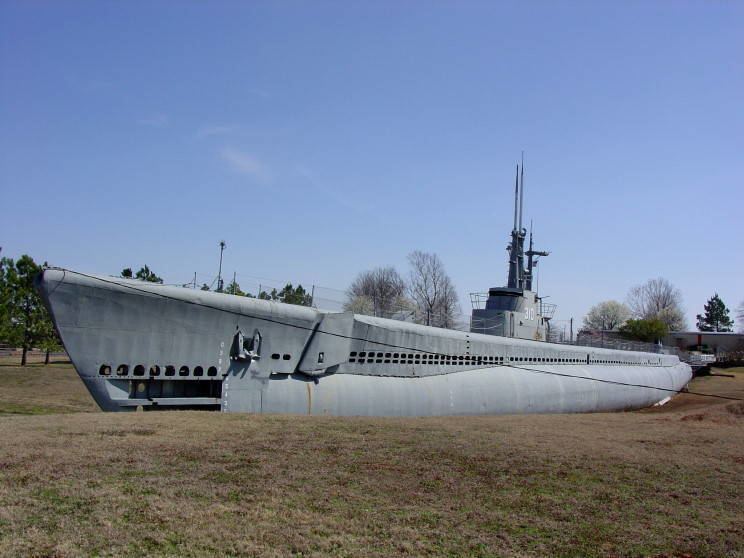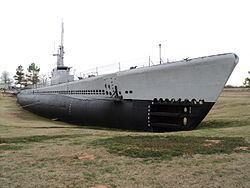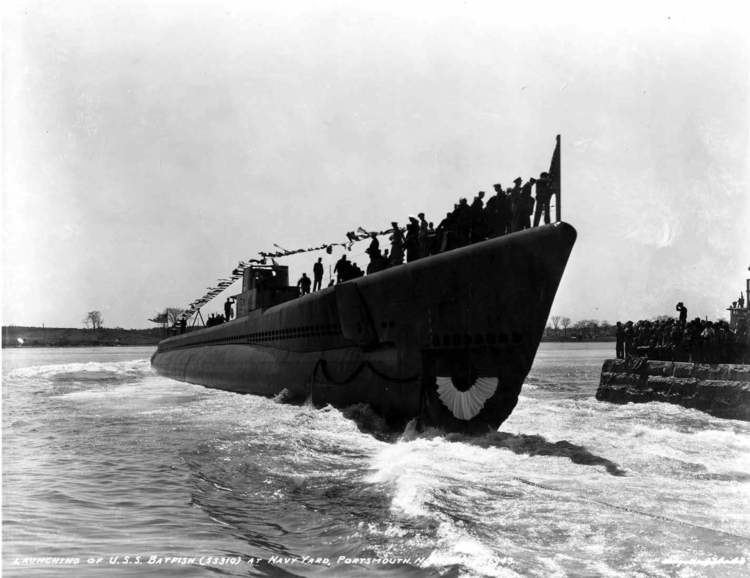Name Batfish Ordered 21 April 1942 Sponsored by Mrs. Nellie W. Fortier Length 95 m Launched 5 May 1943 Commissioned 21 August 1943 | Namesake Batfish Laid down 27 December 1942 Decommissioned 6 April 1946 Construction started 27 December 1942 | |
 | ||
Similar USS Becuna, USS Lionfish (SS‑298), USS Razorback (SS‑394), USS Clamagore (SS‑343), USS Pampanito | ||
USS Batfish (SS/AGSS-310), is a Balao-class submarine, known primarily for the remarkable feat of sinking three Imperial Japanese Navy submarines in a 76-hour period, in February 1945. USS Batfish is the first vessel of the United States Navy to be named for the Batfish, a small pediculate fish resembling the stingray.
Contents
- Construction and commissioning
- 1943 1945
- 1946 1952
- 1952 1969
- Procurement
- Towing and permanent placement
- References

Construction and commissioning

Originally to be named Acoupa, hull SS-310 was renamed Batfish on 24 September 1942 prior to its keel laying on 27 December 1942. The Batfish was constructed at the Portsmouth Naval Shipyard Kittery, Maine and launched 5 May 1943 sponsored by Mrs. Nellie W. Fortier; and commissioned 21 August 1943, with Lieutenant Commander Wayne R. Merrill in command.
1943-1945

Batfish's war operations spanned a period from 11 December 1943 to 26 August 1945 during which she completed seven war patrols. She is credited with having sunk nine Japanese ships totaling 10,658 tons while operating east of Japan, in the Philippine Sea, Luzon Strait, and South China Sea. Batfish received the Presidential Unit Citation for her sixth war patrol in the South China Sea during which she sank the three Japanese submarines. She was also awarded six battle stars for her World War II service.

Combatant vessels sunk were: minesweeper No. 22 on 23 August 1944 at 8°09′N 134°38′E; the destroyer Samidare, 26 August 1944 at 08°30′N 134°37′E; most likely Japanese Submarine RO-115 (since there were several possible IJN subs missing in approximately the same time period and region, along with conflicting claims of sinking by other US surface warships and aircraft) on 10 February 1945 at 18°56′N 121°34′E; Japanese submarine RO-112 on 11 February 1945 at 18°53′N 121°50′E; and Japanese submarine RO-113 on 13 February 1945 at 19°10′N 121°25′E. The Japanese submarines were equipped with radar, which, while helping them locate enemy targets, also made them vulnerable to attack. The Batfish was able to locate them by searching for their radar emissions.
1946-1952

Batfish arrived in San Francisco on 9 September 1945 after the Japanese surrender. After arriving in San Francisco, Batfish was sent to Mare Island Navy Yard for inactive overhaul to prepare the boat for her peacetime service. Following completion of her pre-inactivation overhaul, Batfish was decommissioned on 6 April 1946 and laid up as a training vessel in the Pacific Reserve Fleet.
1952-1969

As the Korean War gained intensity, Batfish received her reactivation overhaul in January 1952 and was recommissioned on 7 March 1952 with Lieutenant Commander Robert J. Jackson in command. She set course via the Panama Canal for Key West, Florida after six weeks of readiness training. She was assigned to Submarine Division 122, U.S. Atlantic Fleet on 21 April. Batfish served the remainder of her commissioned career in training operations in the Caribbean and along the eastern seaboard. She was deactivated for the last time 5 May 1957 at the Charleston Naval Shipyard she was later decommissioned on 4 August 1958 and assigned to the Charleston Group of the Atlantic Reserve Fleet. During the summer of 1959, Batfish was assigned as a naval reserve training vessel in New Orleans, and on 1 July 1960, she was redesignated as an Auxiliary Research Submarine (AGSS-310) on 1 July 1960. She continued to serve at New Orleans until she was laid up in the Atlantic Reserve Fleet and her name was struck from the Naval Vessel Registry on 1 November 1969 after 26 years of Service.
Procurement
Starting in 1969, Oklahoma Submarine veterans were impressed by the USS Drum museum in Mobile, Alabama, which drew over 300,000 paying visitors its first year. A delegation from the Oklahoma City and Tulsa chapters asked the U.S. Navy if they could adopt a retired submarine. On hand at the time in the New Orleans Naval Yard was USS Piranha, which the Navy agreed to turn over to them if they could fulfill the donation requirements. Wanting Piranha for his hometown, then State Senator James Inhofe agreed to sponsor a bill accepting the submarine for Oklahoma.
An initial report claimed that it was impossible to get a submarine as far upriver as Tulsa, due to the Arkansas River Channel not being deep enough above Muskogee, Oklahoma. Later, a direct tow to Muskogee was determined to also not be possible, therefore another method of transport other than direct towing would have to be devised. The Muskogee City-County Trust Port Authority in the meantime donated five acres of prime waterfront real estate for the submarine's berth and memorial park.
The procurement committee met with the Navy for preliminary arrangements for the transfer of Piranha, however the Navy would not hold the submarine unless the committee made a formal application for her with possession being immediate once the donation contract was approved. Since the Arkansas River Navigable Waterway system would not be open for at least a year, interim docking charges would be incurred. The procurement committee decided to wait and take their chances on another submarine being made available.
In September 1970, the procurement committee inspected Batfish as a possible alternative to Piranha, both of which were mothballed at the Naval Inactive Ship Facility in Orange, Texas. Both submarines had suffered considerable neglect, with Piranha being almost completely cannibalized for parts, whereas Batfish was much cleaner and better outfitted. Batfish's better war record compared to Piranha impressed the committee; in 1971, a formal application to acquire Batfish was made. The Navy made no objection to the last-minute swap, and the donation contract was drawn up on 24 June 1971. John H. Chafee, the Secretary of the Navy, approved the transaction and congressional approval was obtained on 8 November 1971.
Towing and permanent placement
On 9 December 1971, ownership of the boat was transferred to the Oklahoma Maritime Advisory Board. The towing was divided into two phases. Phase one was a direct offshore tow from Orange to the Avondale Shipyard in New Orleans. At the shipyard, Batfish would be raised on steel lifting straps and cradled between two pairs of bare-decked barges, so the submarine's draft would be high enough to make phase two of the tow, 1,350-mile (2,170 km) upriver, possible. Strike action at the Orange drydock caused the submarine to instead be towed to the Bethlehem Steel drydock in Beaumont, Texas. After a general inspection and clearing of fuel and ballast tanks, Batfish was sealed up and was ready to tow to Avondale on 1 March 1972. At Avondale, it was found that the four barges were insufficient to reduce the submarine's draft, and a new plan for six 120-by-32-foot (36.6 by 9.8 m) barges, ballasted to the outside and linked together by steel cables. On 13 March, Batfish was partially secured to the barges by lifting straps, but no cables had been placed to bind them together. That afternoon, the English tanker Silverman passed through a nearby 5-knot (9.3 km/h; 5.8 mph) zone at 11 knots (20 km/h; 13 mph): the resulting wake sank one barge and seriously damaged several others, although Batfish herself escaped major harm.
The flotilla of barges was re-assembled, and Batfish was slowly moved up-river by two tugs at 4 knots (7.4 km/h; 4.6 mph). On 3 May 1972 she passed with ease through Lock-and-Dam Number 6, but her superstructure had trouble clearing a bridge on the way into Little Rock, Arkansas, and was only able to pass under when the U.S. Army Corps of Engineers lowered the river level by 3 feet (0.91 m). One tug returned downriver, and the second tug continued the tow towards Fort Smith. Batfish arrived at the Will Brothers Port of Muskogee Terminal on 7 May 1972: this was her temporary home until a 120-foot (37 m) wide, 1⁄4-mile (0.40 km) trench could be dug to the boat's permanent berthing site. On 4 July 1972, while still at Muskogee Terminal, Batfish was unofficially opened to the public. Heavy spring rains flooded the Arkansas River on 12 March 1973, which caused Batfish to strain at her moorings, with fears that she would rip loose and damage the surrounding docks or collide with the new U.S. Route 62 bridge downriver and block the channel. Although the submarine remained moored, the Oklahoma Tourism and Recreation Commission wanted to return the submarine to the Navy. However, the Navy expected Oklahoma to honor its contract.
On 4 April 1973, the trench to the new slipway was completed, and Batfish was maneuvered into position by cables attached to four bulldozers, plus a Port of Muskogee tugboat. Over the next week, further flooding of the slip was used to bring the submarine to her final resting elevation, and by 1 May, she had been realigned to overlook the Arkansas River. Batfish was officially opened on the Memorial Day weekend; by the end of August 1973, the submarine was attracting a thousand visitors a week, with income from paid attendance doubling over the boat's first seven weeks on display. The submarine had been restored well, with the exception of the conning tower, and she is open to the public year round.
